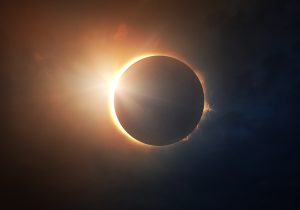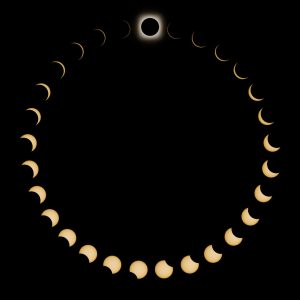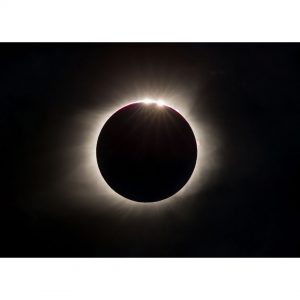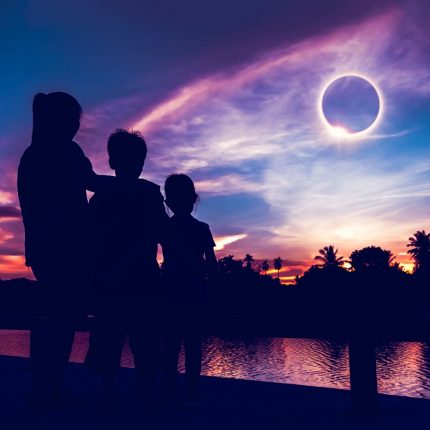The viewing of a solar eclipse is a rare and exciting occurrence. Because they are so rare, it is important to mark and emphasize them in your homeschool. Here is some information and resources on a solar eclipse you can include in your homeschool science studies.
Solar Eclipse Information
What is a Solar Eclipse?
A solar eclipse occurs when the moon moves between the earth and the sun. As this happens, the moon blocks the light from the sun – either completely or partially, depending on your location. If you are in the “path of totality,” then the sun will be completely blocked by the moon for your viewing pleasure! This is a “total eclipse.” A total eclipse is truly a rare sight as the path of totality is so thin. If you’re located outside the path of totality, you’ll observe a partial eclipse.
blocked by the moon for your viewing pleasure! This is a “total eclipse.” A total eclipse is truly a rare sight as the path of totality is so thin. If you’re located outside the path of totality, you’ll observe a partial eclipse.
When Can Eclipses Occur?
Did you know a solar eclipse can only take place during a new moon? For a solar eclipse to occur, the earth, moon, and sun have to be in an almost straight line. We have a new moon each month, so why don’t we have an eclipse each month? This has to do with the orbit, or path, of the moon.
Imagine that the earth is stationary and the sun and moon orbit the earth. (We know that the sun is stationary and the earth orbits the sun, but from our perception here on earth, it looks to us as though we are still and the sun moves.) It seems as though the sun follows a specific path through the sky each day. The moon is also on a fixed path, or orbit, travelling through the sky. However, these paths are not at the same angle. Picture two hula hoops held at different angles. An eclipse can only occur at the space and time where the hula hoops intersect.
Where Do Eclipses Occur?
Solar (and lunar) eclipses actually take place every six months or so, but it will only be visible where the sun, moon, and earth line up. (Remember the hula hoops.) This small shadow can be anywhere in the world. This is why we may only see a couple during our lifetime.
Are all Solar Eclipses the Same?
Surprisingly, no. There are actually 4 types of a solar eclipse. According to NASA:
- “A total solar eclipse happens when the Moon passes between the Sun and Earth, completely blocking the face of the Sun.
- An annular solar eclipse happens when the Moon passes between the Sun and Earth, but when it is at or near its farthest point from Earth. Because the Moon is farther away from Earth, it appears smaller than the Sun and does not completely cover the Sun.
- A partial solar eclipse happens when the Moon passes between the Sun and Earth but the Sun, Moon, and Earth are not perfectly lined up. Only a part of the Sun will appear to be covered, giving it a crescent shape.
- Because Earth’s surface is a curve, sometimes an eclipse can shift between annular and total as the Moon’s shadow moves across the globe. This is a hybrid solar eclipse.”
What is the Difference Between a Solar and a Lunar Eclipse?
While a solar eclipse occurs when the moon moves between the earth and the sun and blocks the sun’s light, a lunar eclipse occurs when the earth is between the sun and moon. As a solar eclipse can only happen during a new moon, a lunar eclipse can only occur during a full moon.
What Does an Eclipse Look Like?
For someone in the path of totality, a total solar eclipse will look something like this:

At the bottom of the photo, the moon begins moving in front of the sun until the sun is hidden – or eclipsed! – by the moon (the top image). It continues on its path until the sun is completely visible once more. So neat!
Can I Look Directly at the Sun During an Eclipse?
We know looking at the sun can damage our eyes, but during an eclipse, the brightness of the sun is blocked, so we would fine to look, right? Wrong. While the temptation may be great, your eyes can still be damaged during an eclipse. The moon may move more quickly than you think and the sun’s rays will reappear without warning. Proper eye protection should be worn at all times while viewing an eclipse.
What May I See During a Total Solar Eclipse?
- The Diamond Ring: During the few seconds before and after a total eclipse, as the moon is just moving into and out of position, a blip of sunlight shows that gives the impression of a diamond sitting atop a ring.

- The Corona: The outer atmosphere of the sun, called the corona, can sometimes show during a total eclipse. It appears as bright, ghostly-looking wisps of gas that are 1.8 million to 3.6 million degrees Fahrenheit (1-2 million degrees Celsius).
- Bailey’s Beads: Named after Francis Bailey, an English astronomer who first noted them, Bailey’s Beads are beads of light that can show around the edge of totality due to imperfections in the surface of the moon that allow bits of light through.
- Chromosphere and Prominences: If one looks closely, he may see a red tint around the edge of the moon/sun. This is the chromosphere, or the lower segment of the sun’s atmosphere. It appears red due to the hydrogen gas and extreme temperatures it contains. Occasionally, one can also see red blotches along the rim. These are large clouds of gas held in place by the sun’s magnetic field and are known as prominences.
Solar Eclipse Dates
Here are a few dates of famous previous solar eclipses or that will be occurring in the United States:
Past
According to the Farmer’s Almanac, the United States’ previous total solar eclipses:
- June 24, 1778
- October 27, 1780
- July 18, 1860
- August 7, 1869
- July 29, 1878
- March 7, 1970
- February 26, 1979
- August 21, 2017
Future
- On October 14, 2023, an annular solar eclipse will cross North, Central, and South America. This eclipse will be visible for millions of people in the Western Hemisphere.
- On April 8, 2024, a total solar eclipse will cross North America, passing over Mexico, United States, and Canada.
- After this eclipse, the next total solar eclipse that can be seen from the United States won’t take place until August 23, 2044!
Solar Eclipse Resources
Incorporating lessons about a solar eclipse may seem like a large task. Thankfully, NASA has put out a lot of information – some of which is specifically for homeschoolers – to get you started!
- NASA has wonderful resources in their new solar eclipse educational materials!
- Check out the American Astronomical Society‘s solar eclipse information.
- Take part in some solar eclipse activities courtesy of NASA.
- National Eclipse will help you prepare for the next total or partial solar eclipse.
- Be sure to tuck away some of these resources from Lesson Planet for your homeschooling.
- The Great American Eclipse has lots of helpful information as well.
A solar eclipse is a special event that only occurs at certain times. The next time one is on the horizon, we hope you’ll be able to take your students on an incredible viewing journey from home!
Additional Homeschool Resources
Space and Astronomy Unit Study
Free Science Resources to Supplement Your Homeschool
Time4Learning’s Homeschool Science Curriculum
Naomi White
Naomi White graduated with her B.S. in Christian Elementary Education and went on to earn her Early Childhood Education certification. She has taught preschool and elementary school in both Christian and public schools. She loves to read and write, is a pastor’s wife and stay-at-home mom, and is eagerly awaiting the day her son is old enough for them to start their own homeschool journey. Originally a Georgia girl, Naomi currently lives in the beautiful mountains of North Carolina with her family.
Latest Posts

Guest Post by Gabriel Morse For several years, I sat for long hours every day behind one of those battleship gray desks in a windowless, dull, gray office. The pay was enough to take care…
Read more >
This post is sponsored by Little Monsters Universe. I'm Tina Salmanowitz, an advocate for homeschooling and science education. With over a decade of experience as a science educator (in class…
Read more >
This post is sponsored by Time4Learning. Before the pandemic, it was business as usual for Boca Raton resident Nikki Warris. Her two daughters, 5-year-old Natalie and 8-year-old Lexi were…
Read more >


